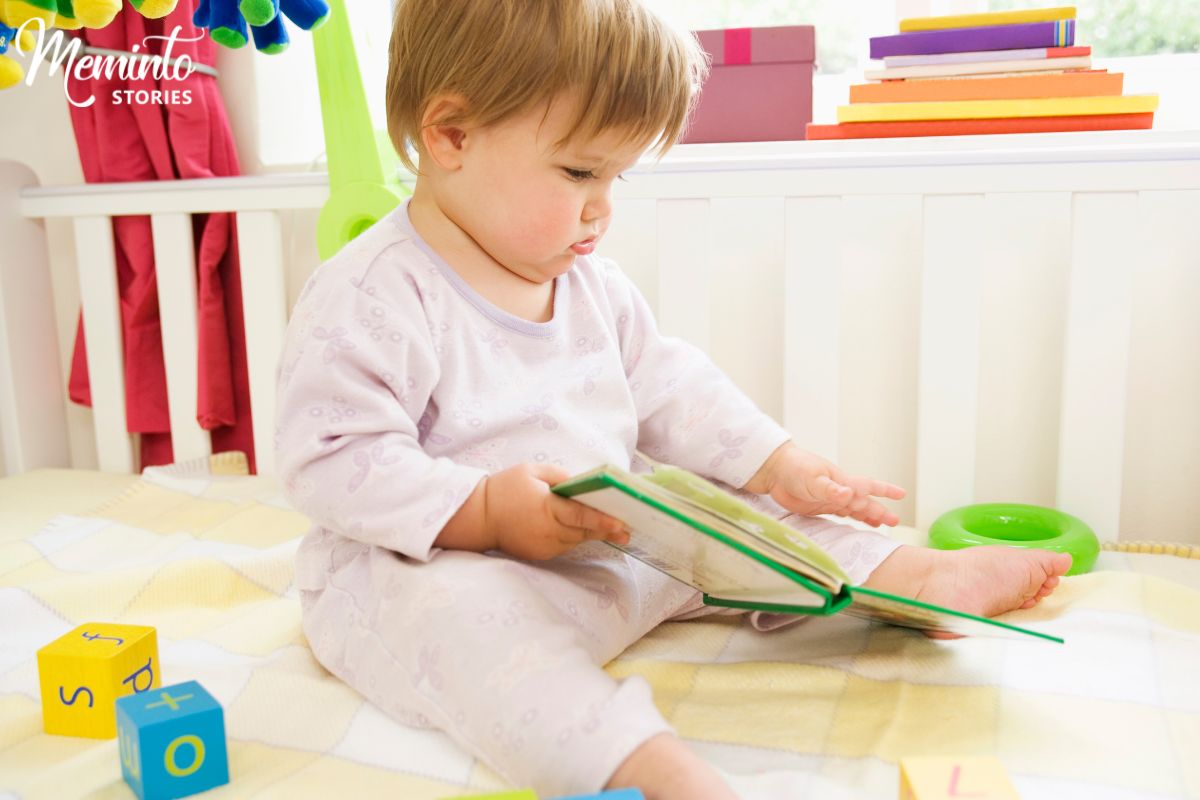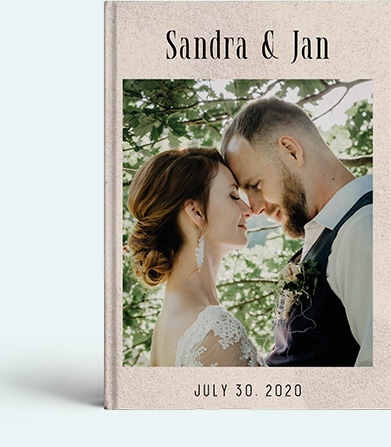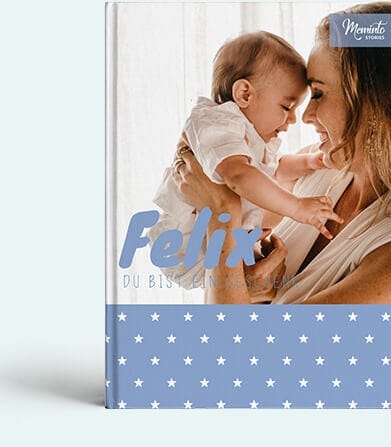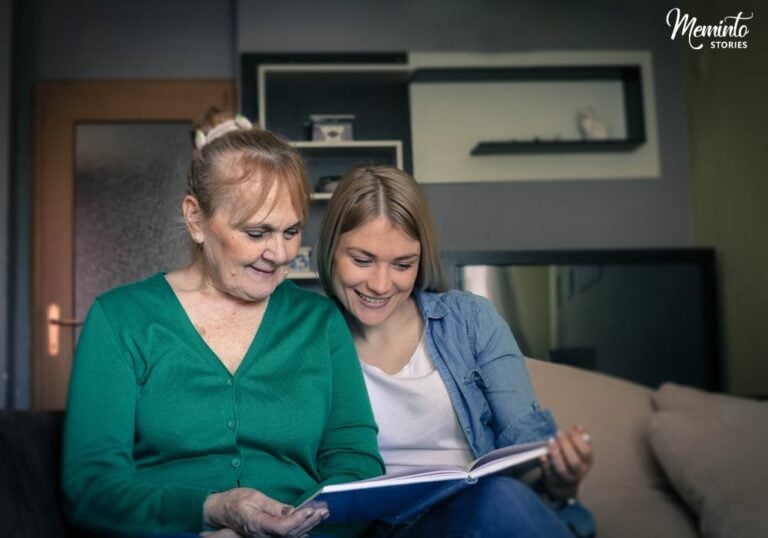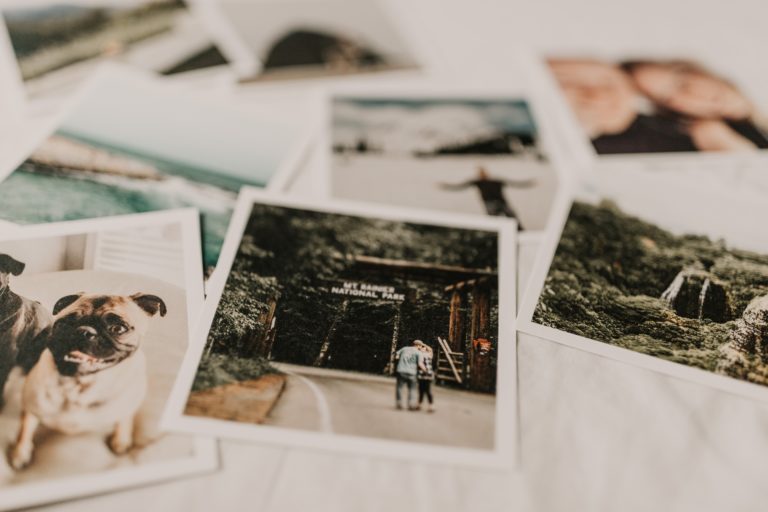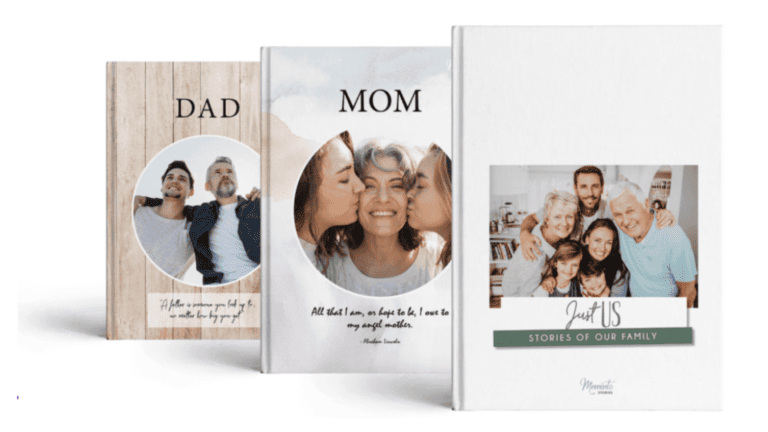The first year flies by in a blur of giggles, sleepless nights, and tiny milestones you swear you’ll never forget. But between bottle feeds and diaper changes, the little details can start to slip away.
That’s why creating a baby memory book for your daughter isn’t just a sweet idea. It’s a way to slow down time and hold on to the magic of her earliest days. From her very first smile to the moment she wrapped her tiny fingers around yours, these memories deserve more than just phone storage. They deserve a space of their own.
This guide shares thoughtful, personal ideas to help you start capturing those moments at your own pace, in your own way.
🗝️ Key takeaways
- A baby memory book preserves the emotional story behind everyday moments that photos alone can’t capture, from first smiles to bedtime routines.
- The most meaningful books blend developmental milestones with personal reflections, family traditions, and the unique personality traits you notice from day one.
- Include voices from your whole family like siblings’ drawings, grandparents’ letters, and cultural traditions to show your daughter how loved and connected she’s always been.
- Tools like Meminto make it easier to create personalized memory books by combining voice notes, photos, and family messages into one printed keepsake.
- Start small and build gradually rather than waiting for the perfect memory, because even simple notes today become treasured proof of love tomorrow.
What to include in a baby memory book for girls
There’s no single way to document your baby’s early days but the most meaningful memory books tend to include a mix of milestones, personal reflections, and everyday moments.
Whether you’re building it page by page or gathering ideas before you begin, here are some thoughtful sections to consider adding.
1. First moments: From birth to first smile
Your baby girl’s story begins with the quiet, powerful beauty of her first days. From her first cry to the way she curled into your arms, these moments are more than just memories. They’re the start of a life that changed yours forever. This section helps you capture the emotions, details, and milestones that marked the beginning of your journey together.
What to Include
Set the tone of your memory book by including meaningful details from her birth and early days:
| Memory Element | What to Capture | |
| Birth Details | Time, date, weight, length, hospital name, birth story | Add a photo of the birth bracelet or hospital tag |
| First Reactions | Your first words to her, her first cry, who was there | Record a short voice note describing how you felt that day |
| Name Meaning | Why you chose her name, who she’s named after, nicknames | Include a scanned page from your journal or notebook |
| Homecoming | The day you brought her home, how you decorated her space | Include snapshots of her crib, first onesie, or visitors |
🎙️ Try voice notes: Want a way to record your voice into her book? Meminto lets you upload voice notes that go right onto the page.
Add a Layer of Emotion
Don’t just document what happened, share how it felt. Consider writing a short reflection titled “The Day We Met” or “Your First Hello.” These personal notes will give life to the timeline. You could also include a mini Q&A like:
- What surprised you most about her birth?
- What emotions filled the room during those first hours?
- What’s one small detail you hope never to forget?
Design Ideas
Use soft colors and gentle layouts to match the tenderness of this section. Consider adding floral borders, delicate photo frames, or subtle background textures. Leave a blank space for handwritten notes or future reflections that may come with time.
✍️ Try this: How to Structure Life Stories Chronologically
2. Her name story
Every name has a story. Some are whispered in dreams before the baby is even conceived. Others come after long debates, baby name lists, or a quiet moment that just feels right. However yours came to you, your daughter’s name carries meaning that’s worth writing down.
Think back to the first time you said her name out loud. Did it feel unfamiliar? Or like you’d been waiting to say it your whole life?
This section is where you capture that story. Write about why you chose her name, what it means, who she might be named after, or the feelings it stirred the moment you saw her face. Maybe there was a song, a book character, or a strong woman in your family whose name you wanted to pass on.
You can also talk about the names you didn’t choose. The ones you almost went with. The ones that didn’t quite fit once you held her. These “almosts” are part of the story too.
If she already has nicknames, write those down as well. The sweet, silly, or surprising ones that have come from siblings or sleep-deprived nights. One day, she’ll smile reading about how her brother used to call her “Toffee” because he thought she was as soft and sweet as candy.
And don’t worry if her name doesn’t have some grand or poetic meaning. What matters is that you chose it. And in doing so, you gave her a part of you to carry for life.
Want to make it even more special? You could include:
- A letter to her, telling her why you gave her this name
- A photo of the moment you introduced her to others
- A printout of how her name looks in your handwriting
These little things might seem small now, but one day, they’ll help her understand just how loved she’s been since the very beginning.
The Meminto Life Book.
Answer a life question weekly and hold a real book in your hands within a year.
3. Monthly milestone pages (0–12 Months)
The first year goes by faster than anyone warns you. One minute you’re learning how to swaddle, and the next you’re chasing a crawling baby who grins like she knows exactly how fast your heart is racing.
That’s why a month-by-month section matters. It’s not just for the big milestones like first teeth or sitting up. It’s for the little things too. The way her smile changed from sleepy to mischievous. The toy she couldn’t fall asleep without. The moment she made eye contact and you knew she recognized you.
You don’t have to write essays every month. Just a few simple notes can bring those memories rushing back:
- What she loved that month (a toy, a lullaby, a specific food)
- What changed (new habits, new expressions, growth spurts)
- A photo that captures her mood or milestone
- A sentence or two about how you were feeling
You need to see this section like a slow-motion reel of her first year. One page per month. One story at a time.
What to Capture Each Month
| Month | Growths & Habits | Firsts to Watch For | Ideas to Include |
| Month 1 | Feeding routines, sleep cycles | First smile (reflex), eye contact | A photo of her sleeping, your favorite lullaby |
| Month 2 | Holding her head up for a few seconds | First cooing sound | A short recording of her voice |
| Month 3 | Longer wake times, starting to follow faces | First real smile | A note on what made her smile |
| Month 4 | Reaching for toys, babbling begins | Laughing, rolling over | Photo of her playtime or tummy time |
| Month 5 | Grabbing objects, more curious expressions | Responding to your voice | Your favorite moment from the week |
| Month 6 | Sitting with support, stronger neck muscles | A solid food taste test | A messy face photo or spoon feeding video |
| Month 7 | Starting to crawl, more active play | Responds to name | A candid photo of her in motion |
| Month 8 | Pulling up to stand, clapping | Waving hello and goodbye | A short note about how she reacts to visitors |
| Month 9 | Copying sounds, peekaboo games | First tooth | A close-up of her tiny smile |
| Month 10 | Standing with help, babbles like conversation | Playing favorites with toys | Photo of her favorite toy or outfit |
| Month 11 | Cruising furniture, mimicking expressions | First steps (or attempts) | Your reaction when she let go for the first time |
| Month 12 | Personality shining through | First birthday celebration | A birthday letter or reflection |
If you missed a few moments, don’t worry. This section is not about perfect records. It’s about pausing long enough to notice the magic in the everyday.
4. Letters to my daughter
There will be so many things you’ll want to say to her over the years. But some of the most powerful words are the ones written when she’s still too little to understand them.
Letters give you space to speak from the heart. They let you pause, reflect, and tell your baby girl the things you might not have the words for in everyday moments. Your hopes. Your fears. The way her presence has changed you. The softness she’s brought into your life.
You don’t need perfect grammar or the right tone. You just need to be honest.
Write about:
- What it felt like the first time you held her
- What kind of woman you hope she becomes
- What’s been hard for you lately and how she makes it easier
- What she’s teaching you without even knowing it
You can write one letter or many. You can title them by age (“To you at 3 months”) or by mood (“On a night when I felt tired but lucky”). You can even invite others – her dad, grandma, or a godparent – to write their own.
Some parents slip these letters between pages of milestones. Others keep a few blank pages at the back of the book just for words that come when the moment feels right.
Want to make them more memorable?
- Add a small photo that matches the memory
- Print them on soft stationery and paste them in
- Record a voice version so she can hear how you sounded in those early days
She may not read them today. But one day, when she’s older and facing her own crossroads, your words will meet her there and remind her that she’s always been deeply known and deeply loved.
Want help writing heartfelt letters? You’ll love this.
5. “Her firsts” timeline
Some firsts come with fanfare. Others slip by quietly and only reveal their importance when you look back. Together, they become a timeline of wonder. Of who she’s becoming. Of how much she’s already done in so little time.
Instead of squeezing all her milestones into one crowded checklist, try giving each first its own space. Let it breathe. Let it shine.
You could format this as a visual timeline across a two-page spread. Or give each “first” a mini storybook moment with space for a date, a photo, and a few sentences that tell what really happened.
Some firsts worth capturing:
- The first time she locked eyes with you and didn’t look away
- The first time she laughed, a real laugh from her belly
- The first time she reached out for something she wanted
- The first time she cried without stopping and you didn’t know what to do
- The first time she slept through the night (or almost did)
- The first time she said “mama” or “dada” and actually meant it
- The first time she stood on her own wobbly feet
- The first time she let go
Not all firsts are picture-perfect. And that’s okay. Sometimes the magic is in the mess. The cereal smeared across her cheeks when she tried solids. The surprised face she made when she touched grass. The tiny tumble before she found her balance.
Try this:
- Draw a soft line across the page with date markers like little milestones
- Add polaroid-style photos or hand-drawn icons for each event
- Use short handwritten captions to tell what made the moment unforgettable
- Leave some space for future firsts still to come
Or take a different route entirely. Make it poetic. Use just your words, one sentence per memory:
“The first time you laughed, I was on the verge of tears. You saved me that day without knowing it.”
These early milestones aren’t just about what she’s doing. They’re glimpses of who she is becoming. And who you are becoming, too.
See also: 10 Family Memory Book Ideas for Milestone Birthdays
6. Her little personality
Even before she could speak, she was already telling you who she was.
In the way she scrunched her nose when she was curious, in the little sigh she let out when she settled into your arms, in the patterns you started to recognize – the toy she always reached for, the song that instantly calmed her, the look she gave when someone new walked into the room.
This part of your memory book is where you begin to notice her. Not just what she did, but how she moved through the world. Her reactions, her preferences, her little ways of being that only someone close enough would notice.
What to Include
Use this section to gently track the small traits that hint at who she’s becoming. You don’t need long reflections. A few sentences per moment are more than enough.
| Personality Clue | Ideas to Capture |
| Expression | Her signature face when she’s thinking, playful, or sleepy |
| Favorites | A toy she always reaches for, a song that lights her up |
| Habits | How she self-soothes, the way she kicks during bath time |
| Reactions | How she responds to music, sudden noises, or familiar voices |
| Social Cues | Whether she’s shy in crowds or lights up when someone walks in |
📸 Visual Tip: Print a photo of her signature face and caption it with what you called it – “the thinking squint,” “grump puff,” etc.
Carole from the USA shared,
“An almost 500-page thick book has been created, and Elise was full of joy.”
Sometimes the joy is not just in what you remember, but in what your child begins to see about herself through your eyes.
You can also create a recurring page that begins with, “Right now, she always…” and fill it in regularly. Simple details like:
- Right now, she always raises her eyebrows when she’s thinking
- Right now, she always claps when the music starts
- Right now, she always hides when a stranger waves
Verena from Austria shared,
“So much more than just a photo book. Through the questions, beautiful old memories come up again.”
Let the questions guide you. What do I love about her right now? What makes her unique, even at this age?
Optional Extras
- Add photos of her go-to facial expressions or moods
- Include quotes from grandparents, siblings, or cousins about her quirks
- Leave a short note about what you admire most in her personality right now
Even as she grows and changes, this section will remind you of the little person she already was from the very beginning.
7. Family & friends who love her
She may not remember the people who rocked her, sang to her, or cried the first time they saw her, but you will. And this section gives you a space to keep those moments alive.
Some of her first bonds will be invisible to her at first. A grandparent who whispered blessings over her. A cousin who gave her a nickname before she could talk. The friend who flew in just to hold her for the first time.
You can fill this section with small, loving snapshots of the people who were part of her beginning. Not just faces, but feelings.
Write down:
- Who came to visit and what they said
- What her big brother or sister did when they first saw her
- The card someone sent that made you cry
- The joke your uncle cracked that finally made you laugh after a hard night
Carole from the USA shared,
“Elise’s grandmother Carole decided to immortalize the first years of Elise’s life in a Meminto Childhood Book. An almost 500-page thick book has been created, and Elise was full of joy.”
Sometimes the gift isn’t just the memory. It’s the fact that someone else took the time to preserve it with you.
Here are a few ways to build this section:
- Add a photo of each person holding her, along with a short message or memory
- Leave space for voice recordings or letters
- Ask grandparents or godparents to write their hopes for her future
- Include drawings, scribbles, or cards from cousins or older siblings
Eileen from Germany shared,
“Thanks to Meminto, I finally had the opportunity to create a great memory book for my children without spending a lot of time.”
Even short messages can mean everything. You don’t need pages and pages – just honest words and heartfelt moments.
This section is your daughter’s first community. Her first reminders that love doesn’t always come with memory, but it always leaves something behind.
🎙️ Try This: Include one voice message per person — even just 10 seconds. Years later, hearing them say her name will mean everything.
8. Special traditions & celebrations
Some memories don’t need a calendar to be remembered. They live in repetition – routines, songs you hum while dressing her, prayers whispered before bedtime, the cake that only comes out on birthdays, and the silly dance Dad does every Sunday morning.
This section is about the rhythm of your family life. The traditions, holidays, and little rituals that make your home feel like home.
You don’t need to wait for big events. You can start with the small, consistent things.
What to include:
- A photo from her first birthday celebration, with cake on her face and laughter in the room
- A note about your naming ceremony, dedication, or christening
- A short write-up about the family recipe that always makes an appearance during holidays
- Captions for her first Christmas outfit, Diwali dress, or Eid morning giggle
- A reflection on the first family reunion she attended, even if she slept through most of it
These are the chapters she won’t remember but will grow up surrounded by.
Selma from the UK shared,
“With Meminto Stories I found a way to keep all my flashbacks of the first adventure with our child in a book. Now we can cherish them forever.”
Let this section hold your flashbacks. Not just what happened, but how it felt.
You could design it like a timeline or create themed spreads:
- Holiday Moments: A mix of photos, short notes, and family sayings
- Birthday Milestones: Add guest messages, party details, and candle photos
- Cultural Traditions: Write a few sentences about what each event means to your family and how you hope to pass it on
- Unexpected Celebrations: Like the night she slept through for the first time or the dance party you had just because she smiled
Don’t forget to include voices beyond your own. It could be a grandparent’s memory, a sibling’s comment, or a family friend’s inside joke.
See more: How to Scrapbook While Traveling
9. The things we never want to forget
Some stories don’t start with “once upon a time.” They begin in small kitchens. On long walks. In quiet glances between generations. And before you realize it, they become lessons.
This section is where you pass them on.
Maybe your daughter will grow up never meeting the great-grandmother who taught you patience through action, not words. Or maybe one day she’ll ask why Grandpa always kept his shoes by the door. These aren’t just details. They’re threads in the bigger story of who she comes from.
The lessons you didn’t know were lessons
You might not think of your family as traditional, but most values are passed down without ceremony. They show up in how you hold someone’s hand when they cry. In why you never waste food. In how you show up, even when it’s hard.
Verena from Austria shared,
“So much more than just a photo book. Through the questions, beautiful old memories come up again. Even videos could be loaded into the book. Emotions like when it all happened.”
You can capture those memories and moments by sharing the little things that shaped you.
Ideas for what to include
| Lesson Type | |
| Words that stayed | Family sayings, quotes, or advice often repeated across generations |
| Silent traditions | Habits or customs passed down without explanation (e.g., Sunday cleaning, meal prep rituals) |
| Everyday wisdom | Personal stories with a clear takeaway (like learning to fix something, handle heartbreak, or be generous) |
| Cultural roots | Short reflections on heritage, customs, or rituals and what they mean to your family |
| Visual memory | Photos of a family elder with their handwriting, tools, or favorite things |
Try this:
- Write a letter titled “What I learned from…” and fill in the blank with a loved one’s name
- Record a voice note of an elder sharing a story, then transcribe it here
- Ask your parents or grandparents: “What’s something you learned too late?” and include their answers
- Pair an old photo with a reflection. What does it remind you of? What did that moment teach you?
Not everything needs to be profound. Sometimes the greatest life lesson is learning how to fold a fitted sheet or how to apologize with grace.
These pages will show her that while the world may change, the heart of your family – its values, stories, and strength – remains.
10. Hopes & dreams for her future
Sometimes the sweetest memories come from the smallest voices.
This section is where siblings, cousins, or family friends get to speak for themselves. They may be too young to write full letters, but that doesn’t stop them from leaving their mark through drawings, voice notes, or the funny things they blurt out at the dinner table.
Even a scribble or a single sentence can hold a memory that lasts.
Carolin from Germany shared,
“What I really liked is the 10 percent discount for creating a second book for another child after the first one. With the capacity for up to 250 pictures, it’s also cheaper than a photo book, especially with 300 pages.”
Many parents use this section to create space for each child, so no one is left out of the story.
What younger family members can contribute
| Age Group | What They Can Add | How You Can Help |
| Age 3-5 | Drawings, finger painting, voice recordings | Ask simple prompts like “What do you love about the baby?” |
| Age 6-9 | Short notes, lists, audio messages | Help with spelling, or turn a conversation into a letter |
| Age 10-13 | Letters, comics, favorite memories together | Light editing or layout help |
| Age 14+ | Written reflections, jokes, even advice | Encourage authenticity, no perfection needed |
Turning their love into keepsakes
You might be surprised by how much thought little ones put into their messages, especially when they know it’s going into a “real book.” Some will write letters. Others will draw or record something short and sweet. But all of it matters.
What makes this part special isn’t how much is written. It’s the feeling behind it.
Try this: Gather their words over time
Instead of rushing everyone to contribute in one sitting, take your time. Sometimes the most memorable messages come out of nowhere – during play, bedtime, or car rides. Write it down before it slips away.
Something like:
“She’s going to be a star. Not the kind in the sky. The kind that wins dance shows.” – Naomi, age 7
Make it visual, playful, and honest
You could pair their messages with:
- A photo of them and your daughter laughing
- A drawing they made just for her
- A printed version of a voice note, with their exact words and tone
These aren’t just entries. They’re tiny windows into how your child is seen by the people who’ll grow up right beside her.
Remind them it’s not about being perfect
Tell them this page isn’t about writing like grownups. It’s about sharing love, imagination, and those wild, funny, beautiful hopes they already have for her. Even if it’s, “I hope she grows tall enough to reach the cookie shelf.”
Let them own their words. Their spelling. Their quirks. One day, your daughter will read them and feel something you can’t explain. Proof that she mattered from the very beginning.
How can you personalize your baby memory book
No two babies are alike and no two families tell stories the same way.
That’s why a memory book shouldn’t feel like a template you have to fill in. It should feel like home. Something that grows with your child, shaped by your voice, your culture, your little routines.
So if you’re wondering how to make it truly yours, here’s what that could look like.
1. Make space for your family’s rhythm
Every family has its own beat.
Maybe your nights are filled with music and dancing. Maybe your mornings start with prayers whispered into tiny palms. Don’t just answer the questions in the book. Add what feels natural to your life.
You can insert custom pages like:
- “Our lullaby and what it means to us”
- “Sunday rituals in our home”
- “How we say ‘I love you’ around here”
2. Use language that feels like you
Whether you speak one language or three, your words matter. You don’t need perfect sentences. Just write how you talk.
One mom had mentioned how she added a page of common phrases she says to her baby in her local dialect so her daughter could always remember the sound of home.
3. Add keepsakes beyond photos
Photos are beautiful. But they’re not the only way to remember.
Consider adding:
| Keepsake Idea | Why It Matters |
| A fabric swatch from a baby blanket | Adds texture and story to a page |
| A tiny footprint or handprint | Marks growth in a physical, visible way |
| Your hospital bracelet or tag | Anchors the moment she entered your world |
| A letter from a grandparent | Preserves generational love and advice |
| Her first scribble or doodle | Shows her story from her own hand, not just yours |
4. Let the mess in
Not everything has to be curated. Leave in the wrinkled drawing, the typo, the sticker she placed upside down. These are the moments that will feel the most alive years from now.
Personalizing isn’t about making it perfect. It’s about making it feel like your story, one only your family could tell.dollar rate
Get inspired: Easy and Fun Autobiography Outline Template
Get $10 off your first Meminto book project 📖
We appreciate you for reading this article. As a token of our gratitude, we would like to offer you a special $10 discount on your first book with Meminto!
A final note
Years from now, your daughter might open this book on a quiet afternoon, maybe while packing for college or holding a baby of her own. She’ll flip through the pages, pausing at the ones where you wrote to her, where her brother scribbled her name, where her tiny footprints once fit.
And in that moment, it won’t just be a book. It will be proof of how deeply she was loved, even before she could understand it.
You don’t have to fill every page in one sitting or wait for the perfect memory. Just start. Capture what feels true, and little by little, you’ll be building something she’ll hold close for the rest of her life.
Because this story is hers, but it begins with you.
Want a little help getting started? With Meminto Stories, you can turn your memories into a printed baby book that includes voice notes, photo timelines, and family messages all in one place.
Capture what feels true, and little by little, you’ll be building something she’ll hold close… And when you’re ready, we’ll help you print it.


